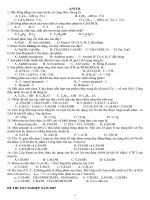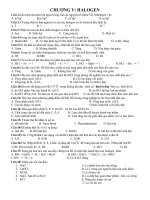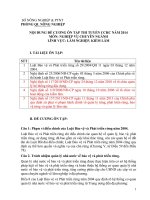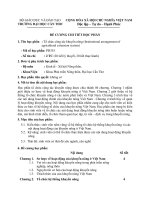Đề cương trắc nghiệm Hành Vi Tổ Chức (Organizational Behavior) CHƯƠNG 11
Bạn đang xem bản rút gọn của tài liệu. Xem và tải ngay bản đầy đủ của tài liệu tại đây (49.48 KB, 15 trang )
Chapter 11: Creativity and Team Decision
Making
11-1. Creativity potentially improves which stage in the decision-making
process?
a. Problem identification
b. Identifying alternative choices.
c. Implementing solutions more effectively.
d. All of the above.
e. Only 'a' and 'b'
The question was not answered. The correct answer
is "d". (Coaching responses are only available for answered questions)
11-2. Which of these represent the correct sequence of stages in the
creativity model?
a. Preparation, Incubation, Insight, and Verification
b. Insight, Preparation, Incubation, and Verification
c. Insight, Verification, Incubation, and Preparation
d. Incubation, Insight, Preparation, and Verification
e. Incubation, Verification, Insight, and Preparation
The question was not answered. The correct answer
is "a". (Coaching responses are only available for answered questions)
11-3. Reframing problems in a unique way and generating different
approaches to the issue is called
a. brainstorming.
b. groupthink.
c. divergent thinking.
d. evaluation apprehension.
e. a devil's advocate.
The question was not answered. The correct answer
is "c". (Coaching responses are only available for answered questions)
11-4. What type of intellectual abilities help people to be more creative?
a. Ability to synthesize information.
b. Practical ability
c. Analytic intelligence
d. All of the above
e. Intelligence has no effect on creativity.
The question was not answered. The correct answer
is "d". (Coaching responses are only available for answered questions)
11-5. Employees are usually less creative when they:
a. enjoy taking risks.
b. are given more job security.
c. interact regularly with co-workers in other areas of the organization.
d. have a high need for social approval.
e. have all of the above.
The question was not answered. The correct answer
is "d". (Coaching responses are only available for answered questions)
11-6. A researcher wanted to find a new product that would temporarily
stick objects to desks and walls. While watching his daughter chewing
gum, he thought about how gum has features that might fulfil this need.
This incident is an example of:
a. escalation of commitment.
b. brainstorming.
c. divergent thinking.
d. groupthink.
e. Delphi technique
The question was not answered. The correct answer
is "c". (Coaching responses are only available for answered questions)
11-7. Morphological analysis is:
a. A structured associative-play activity to improve creativity.
b. The trap that teams fall into during group polarization.
c. One of the four elements of brainstorming.
d. The structured activity required by participants to engage in Delphi
technique decisions.
e. The only reasonable way to minimize groupthink.
The question was not answered. The correct answer
is "a". (Coaching responses are only available for answered questions)
11-8. Which of the following is a creative practice that mainly tries to
redefine the problem?
a. Morphological analysis
b. Jamming
c. Object-oriented story telling
d. Cross-departmental information sessions or "demo days"
e. Production blocking
The question was not answered. The correct answer
is "b". (Coaching responses are only available for answered questions)
11-9. Which of the following statements about evaluation apprehension
in team settings is FALSE?
a. Evaluation apprehension increases the individual's motivation to
share his or her ideas
b. Evaluation apprehension is more likely to occur when team members
formally evaluate each other's performance throughout the year
c. Evaluation apprehension is based on the individual's desire to create a
favourable self-presentation and need for social esteem
d. Evaluation apprehension occurs when employees believe that other
team members are silently evaluating them
e. Evaluation apprehension is most common when the meeting is
attended by someone with higher status or expertise.
The question was not answered. The correct answer
is "a". (Coaching responses are only available for answered questions)
11-10. A time constraint in meetings due to the procedural requirement
that only one person may speak at a time called
a. evaluation apprehension.
b. groupthink.
c. selective attention.
d. production blocking.
e. group polarization.
The question was not answered. The correct answer
is "d". (Coaching responses are only available for answered questions)
11-11. A person's reluctance to mention ideas that seem silly or
peripheral in order to create a favourable self-image refers to
a. evaluation apprehension.
b. groupthink.
c. selective attention.
d. production blocking.
e. group polarization.
The question was not answered. The correct answer
is "a". (Coaching responses are only available for answered questions)
11-12. Which of these is the tendency of highly cohesive groups to value
consensus at the price of decision quality?
a. Production blocking
b. Groupthink
c. Evaluation apprehension
d. Group polarization
e. Escalation of commitment
The question was not answered. The correct answer
is "b". (Coaching responses are only available for answered questions)
11-13. Which of these is not a symptom of groupthink?
a. Mindguarding
b. Self-censorship
c. Illusion of vulnerability
d. Rationalization
e. All of these are symptoms of groupthink.
The question was not answered. The correct answer
is "c". (Coaching responses are only available for answered questions)
11-14. __________ refers to the tendency of teams to make more
extreme decisions than individuals working alone.
a. Groupthink
b. Synergy
c. Selective attention
d. Escalation of commitment
e. Group polarization
The question was not answered. The correct answer
is "e". (Coaching responses are only available for answered questions)
11-15. All of these are brainstorming rules EXCEPT:
a. Say all ideas that come to mind, no matter how wild.
b. Build on the ideas of others.
c. Identify problems with other people's ideas as soon as they are
presented.
d. Provide as many ideas as possible.
e. Speak freely.
The question was not answered. The correct answer
is "c". (Coaching responses are only available for answered questions)
11-16. Group polarization explains:
a. why some people are more creative than others.
b. the tendency of teams of value consensus at the price of decision
quality.
c. why employees are reluctant to mention ideas to others that seem silly
or peripheral.
d. why individuals engage in escalation of commitment.
e. Why teams tend to make more extreme decisions than individuals
making the decision alone.
The question was not answered. The correct answer
is "e". (Coaching responses are only available for answered questions)
11-17. A structured team decision-making process of systematically
pooling the collective knowledge of experts on a particular subject to
make decisions, predict the future, or identify opposing views is called
a. brainstorming.
b. nominal group technique.
c. electronic brainstorming.
d. Delphi technique.
e. constructive controversy
The question was not answered. The correct answer
is "d". (Coaching responses are only available for answered questions)
11-18. Nominal group technique has all of the following features
EXCEPT:
a. Participants do not meet face-to-face.
b. Nominal group technique follows an individual, then team, then
individual process.
c. Nominal group technique discourages criticism or debate.
d. After the problem is described, team members silently and
independently write down as many solutions as possible.
e. After ideas have been presented, participants silently and
independently rank order or vote on each proposed solution.
The question was not answered. The correct answer
is "a". (Coaching responses are only available for answered questions)
11-19. Select the team decision making structure that best minimizes
production blocking.
a. Face-to-face meetings
b. Constructive controversy
c. Nominal group technique
d. Electronic brainstorming
e. Brainstorming
The question was not answered. The correct answer
is "d". (Coaching responses are only available for answered questions)
TRUE or FALSE
11-1. People are more creative when they initially spend time studying
the problem of issue.
True / False
The question was not answered. The correct answer
is "True". (Coaching responses are only available for answered
questions)
11-2. Divergent thinking occurs when several people form a common
mental model.
True / False
The question was not answered. The correct answer
is "False". (Coaching responses are only available for answered
questions)
11-3. Divergent thinking occurs during the preparation stage of the
creative process model.
True / False
The question was not answered. The correct answer
is "False". (Coaching responses are only available for answered
questions)
11-4. According to the textbook, there is only weak evidence that "rightbrained" people are more creative than "left-brained" people.
True / False
The question was not answered. The correct answer
is "True". (Coaching responses are only available for answered
questions)
11-5. In spite of their ability to synthesize divergent information, most
creative people have a relatively low analytic intelligence.
True / False
The question was not answered. The correct answer
is "False". (Coaching responses are only available for answered
questions)
11-6. Job security tends to have a favourable influence on creativity.
True / False
The question was not answered. The correct answer
is "True". (Coaching responses are only available for answered
questions)
11-7. Creative productivity increases when people engage in selfleadership.
True / False
The question was not answered. The correct answer
is "True". (Coaching responses are only available for answered
questions)
11-8. Jamming and morphological analysis are brainstorming activities.
True / False
The question was not answered. The correct answer
is "False". (Coaching responses are only available for answered
questions)
11-9. Morphological analysis is a more structured convergent thinking
activity.
True / False
The question was not answered. The correct answer
is "False". (Coaching responses are only available for answered
questions)
11-10. Production blocking occurs when an employee decides not to
mention an idea because it sounds silly or trivial.
True / False
The question was not answered. The correct answer
is "False". (Coaching responses are only available for answered
questions)
11-11. Groupthink can occur when the team leader is opinionated and
the team lacks clear guidance from corporate policies or procedures.
True / False
The question was not answered. The correct answer
is "True". (Coaching responses are only available for answered
questions)
11-12. Constructive controversy occurs when team members debate their
different perceptions about an issue in a way that maximizes
socioemotional conflict.
True / False
The question was not answered. The correct answer
is "False". (Coaching responses are only available for answered
questions)
11-13. Brainstorming is based on the idea that quality increases with the
number of ideas presented.
True / False
The question was not answered. The correct answer
is "True". (Coaching responses are only available for answered
questions)
11-14. Electronic brainstorming significantly reduces the problem of
evaluation apprehension.
True / False
The question was not answered. The correct answer
is "True". (Coaching responses are only available for answered
questions)









